Two or more dogs are great company for each other and can be double the fun for you and your family. But owning multiple dogs can be challenging and time-consuming.
If you’re considering getting a second dog, you’ll wonder how to house multiple dogs. Should each dog have their own dog house? And how do you house multiple dogs?
Read this guide to learn about managing a multiple-dog household and find out if getting a second dog is a good idea.
How To Manage A Multi-Dog Household
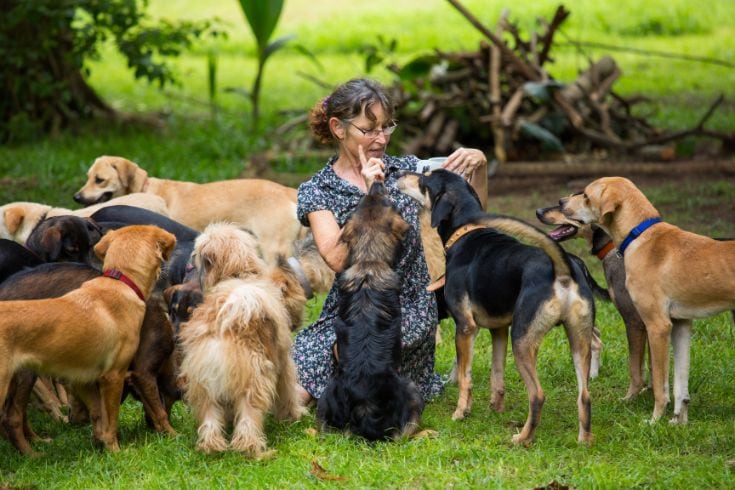
Dogs are naturally pack creatures that have evolved to live in small canine family groups. Owning more than one dog can help to prevent separation anxiety when you’re not around; the dogs can keep each other company, play together, and form strong bonds.
However, if the arrangement is to work well, you’ll need to manage your multi-dog household correctly.
Who’s In Charge?
Although the belief that dogs have a hierarchy within a pack has been somewhat dispelled, they still look to a more senior pack member for guidance and direction.
If the dogs are allowed to work things out themselves, you’re effectively telling them that you don’t want to get involved when there’s social conflict. So, when you need to get the dogs’ attention in an emergency situation, they won’t look to you for guidance.
Resource Competition
Dogs often compete over resources, including:
- Your attention
- Eye contact
- Affection and praise
- Locations in your car and the house
- Food
- Toys
- Beds
You can mitigate that conflict successfully if you’re prepared.
For example, each dog must wait their turn for food and affection, respond to their names, understand how to leave or drop objects, sit, stay, and look at you.
Time Out!
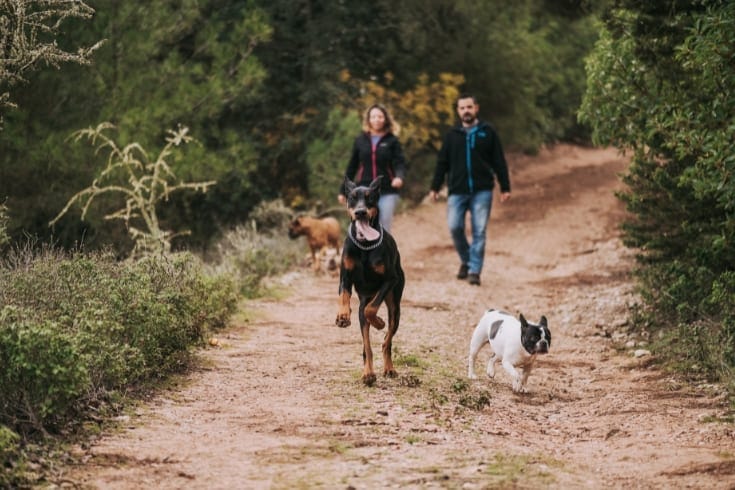
Teach your dogs that you will only give them your attention, games, petting, toys, etc., when they are nice to each other.
If the dogs bully each other or misbehave, remove whatever triggered that behavior and give the dogs a time-out. Going forward, manage the situation carefully so that the same problem doesn’t recur.
Resource Guarding
You can prevent competition between the dogs by providing plenty of resources to go around. That way, the dogs won’t be tempted to fight over one toy, dog bed, water bowl, etc.
If the dogs growl at each other or start fighting over a perceived valuable resource, don’t punish them for their behavior; simply remove the object. When training your dogs, always use reward-based, positive reinforcement techniques, never punishment.
Name Game
Remember to use each dog’s name frequently and routinely so that each one can work out who is getting your attention. If other dogs try to muscle in when you’re focusing on an individual, turn your back on them or don’t make eye contact.
Manners
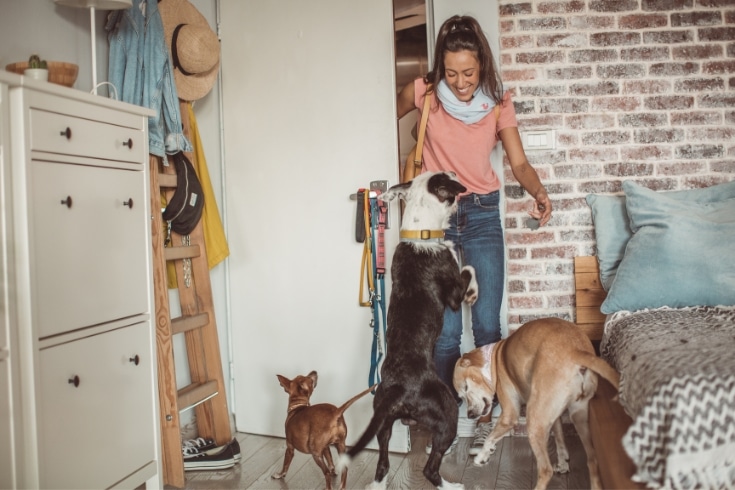
Your canine family will be much easier to manage if you have well-behaved dogs, and aggressive behavior is easier to manage if your dogs are well-trained.
- If the pups crowd you, jump up at you, or try to bully each other to get your attention, don’t give in and pet them or acknowledge their attention-seeking behavior. Instead, teach the dogs that behavior is unacceptable and only reward polite manners.
- The dogs must wait at mealtime and for treats and have separate eating locations so they don’t intrude on or bully each other.
- Teach the dogs to wait before going outside rather than pushing past you and barging when you open the door for them.
- Do not allow the dogs to compete for your attention. If you’re petting one dog, don’t let the others intrude by petting him instead. Remember, you’re the leader; the dogs must wait for your attention, not demand it.
That all sounds pretty straightforward, and, as you can see, much of multiple-dog management is merely common sense. However, there are a few tips and tricks you should know to keep the peace in your multi-dog household!
How To Keep The Peace
No matter how careful you are, there’s bound to be some conflict and disorder from time to time.
Here are a few tips on how to keep the peace in your multiple-dog household.
Behavior Management
While training all your dogs to get along, use training tools, such as crates, leashes, tethers, and baby gates, to keep order.
Always use positive training methods, and don’t be afraid to get professional help from a qualified dog trainer or animal behaviorist if you need it.
Keep Calm
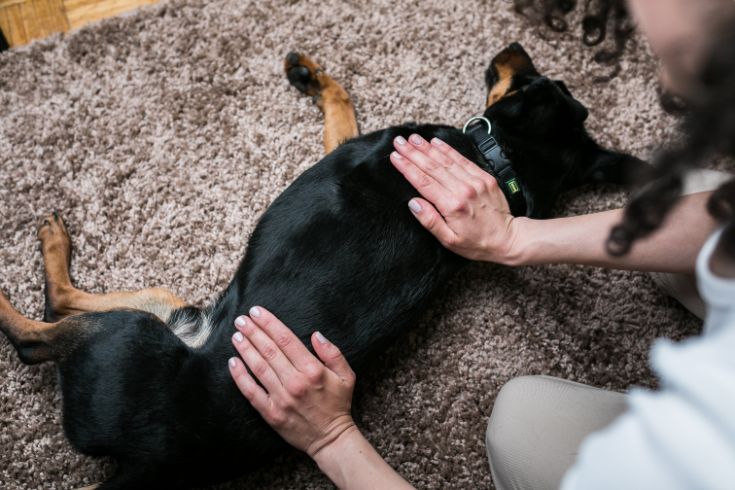
Stress and fear cause aggression in dogs. By keeping calm and relaxed around your dogs, you can help to diffuse potential conflicts.
So, don’t yell or shout when the dogs are squabbling; that will only make matters worse. Keeping a plywood board on hand can be helpful so that you can quickly slip it between the warring factions to separate rather than risk getting bitten.
Make a mental note of why the problem occurred in the first place, and take steps to ensure the same situation doesn’t arise again.
Medical Conditions
Sometimes, if one of the dogs has a medical condition, that can exacerbate tensions within the dog pack. Stress causes aggression, so manage medical conditions or pain in your dogs.
For example, one of my dogs suffered from canine dementia as she got older, which made her very tense and anxious. Fortunately, my vet diagnosed the condition and prescribed medication to manage it. If you have any concerns about your dogs’ health, always seek veterinary advice as soon as possible.
Exercise
All dogs need exercise, no matter what age or breed they are. In a pack situation, if one dog is overexcited and full of beans, that quickly spreads to the other pups, and chaos can quickly break out!
Take your dogs for regular walks or to the dog park for a good game and social experience. If you have a large backyard, you can spend time training your dogs too. Mental stimulation is a very important form of exercise and can wear your furry friends out just as much as a 10-mile hike!
Individual Quality Time
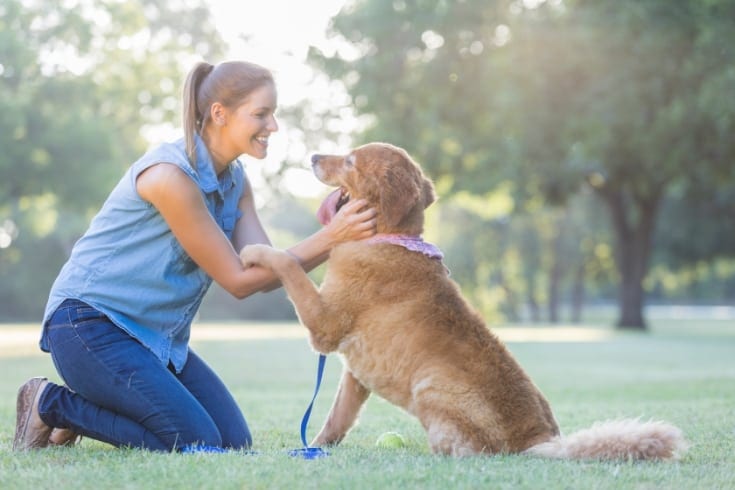
It’s essential that you set aside some quality time to spend with each of your dogs away from the others.
That’s essential for training purposes and can help to build a bond between you, making it easier to establish your position as a sympathetic, benevolent leader, which is essential for effective pack management.
Protect Vulnerable Dogs
If you have a puppy, a disabled or sick dog, or an elderly pup, you’ll need to ensure that they are physically safe from more boisterous pack members.
If necessary, you’ll need to separate that dog from the rest of the group until he’s strong enough to rejoin his companions safely.
How Do I House Multiple Dogs?
Keeping more than one dog can be chaotic when you’re not around to watch them, and individual training sessions are essential.
So, how can you house and train multiple dogs?
Separate Rooms
Training the dogs in separate rooms is the easiest way to prevent jealousy or anxiety.
When you take one dog into a separate room for his training session, remember to leave the other dog with a game or toy to keep him occupied until it’s his turn. Keep training sessions short so no dog is left alone for too long.
If you think squabbles will break out while you’re not there to watch the dogs, it’s sensible to house them in separate rooms overnight and if you go out.
Crates and Tethers
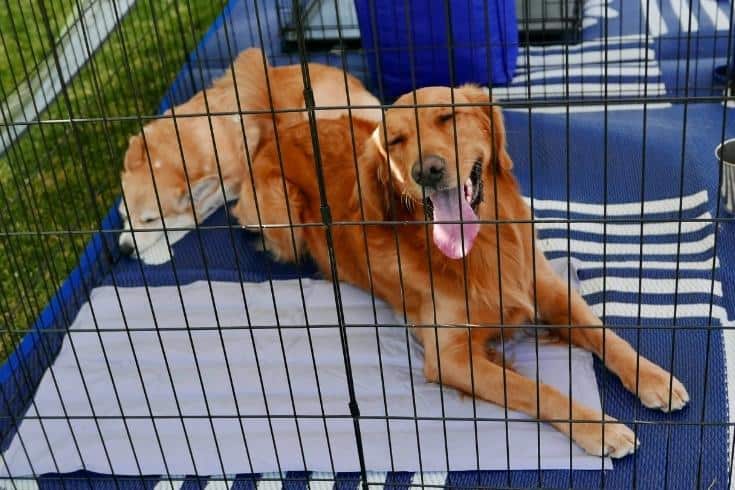
It’s actually helpful to have one dog in the room while you’re training another pup. That way, the observer can learn by watching the other dog’s behavior. That’s fascinating, and I can vouch for the fact that observational training works!
My Shih-Poo puppy was “helping” me in the garden while I was weeding by grabbing hold of random leaves and trying to pull them up! At just eight weeks old, Raffles had watched my behavior and copied it; that’s amazing!
So, you can either put the observer pup in a crate or tether him with a leash near a mat or bed while you train the other dog. Remember to reward the observer frequently for good behavior.
FAQs
In this part of our guide, we answer some of the most frequently asked questions about how to manage multiple dog households.
Q: Will two dogs share a dog house?
A: It’s generally not recommended for two dogs to share a dog house or kennel. A dog house is usually regarded as a valued resource that provides shelter for the dogs, and there’s a danger that the dog might fight over that if forced to share.
So, ideally, each dog should have his own dog house. Of course, you can buy double dog houses, which are basically two single dog houses built alongside one another with separate entry doors. That arrangement can be useful if you want to save space.
Q: Are dogs in a multi-dog household happier?
A: As long as they are managed correctly, and the house isn’t too small to accommodate them, well-trained dogs are typically happier and more settled if they have canine company.
Q: Is it too much to have four dogs?
A: The dynamics of keeping four dogs are complex. For a start, you must have a large enough home to comfortably accommodate the dogs and your family, as well as lots of outside space where the dogs can exercise.
In addition, you must be able to afford the time and financial expense of keeping four dogs, which could be unlikely if you work full-time.
Final Thoughts
I hope you enjoyed our guide to owning multiple dogs. If you found the article helpful, please share it with other dog lovers!
Housing and managing more than one dog can be challenging. However, with some thought and practical adjustments to your home, owning multiple dogs can be done successfully without too much hassle or expense.
The dogs must be well-trained and get along together for a harmonious multi-dog household. Conflict can be managed by keeping the dogs separate in different rooms when you’re not there to supervise them, and you can use crates and tethers when training.
How many dogs do you own? What breed are they? Tell us in the comments box below!
